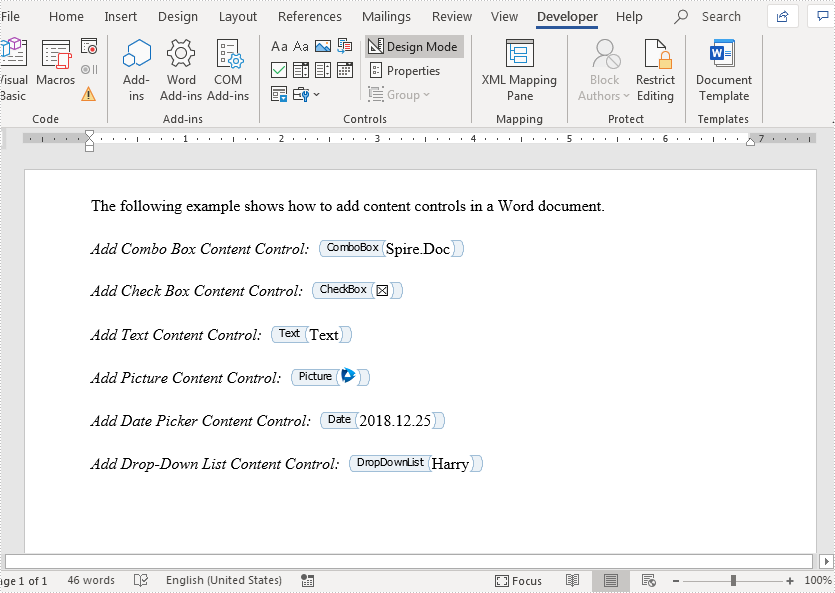Java: Split Word Documents
When you have a fairly long Word document that requires teamwork, it may be necessary to split the document into several shorter files and assign them to different people to speed up the workflow. Instead of manually cutting and pasting, this article will demonstrate how to programmatically split a Word document using Spire.Doc for Java .
Install Spire.Doc for Java
First, you're required to add the Spire.Doc.jar file as a dependency in your Java program. The JAR file can be downloaded from this link. If you use Maven, you can easily import the JAR file in your application by adding the following code to your project's pom.xml file.
<repositories>
<repository>
<id>com.e-iceblue</id>
<name>e-iceblue</name>
<url>https://repo.e-iceblue.com/nexus/content/groups/public/</url>
</repository>
</repositories>
<dependencies>
<dependency>
<groupId>e-iceblue</groupId>
<artifactId>spire.doc</artifactId>
<version>13.11.2</version>
</dependency>
</dependencies>
Split a Word Document by Page Break
A Word document can contain multiple pages separated by page breaks. To split a Word document by page break, you can refer to the below steps and code.
- Create a Document instance.
- Load a sample Word document using Document.loadFromFile() method.
- Create a new Word document and add a section to it.
- Traverse through all body child objects of each section in the original document and determine whether the child object is a paragraph or a table.
- If the child object of the section is a table, directly add it to the section of new document using Section.getBody().getChildObjects().add() method.
- If the child object of the section is a paragraph, first add the paragraph object to the section of the new document. Then traverse through all child objects of the paragraph and determine whether the child object is a page break.
- If the child object is a page break, get its index and then remove the page break from its paragraph by index.
- Save the new Word document and then repeat the above processes.
- Java
import com.spire.doc.*;
import com.spire.doc.documents.*;
public class splitDocByPageBreak {
public static void main(String[] args) throws Exception {
// Create a Document instance
Document original = new Document();
// Load a sample Word document
original.loadFromFile("E:\\Files\\SplitByPageBreak.docx");
// Create a new Word document and add a section to it
Document newWord = new Document();
Section section = newWord.addSection();
int index = 0;
//Traverse through all sections of original document
for (int s = 0; s < original.getSections().getCount(); s++) {
Section sec = original.getSections().get(s);
//Traverse through all body child objects of each section.
for (int c = 0; c < sec.getBody().getChildObjects().getCount(); c++) {
DocumentObject obj = sec.getBody().getChildObjects().get(c);
if (obj instanceof Paragraph) {
Paragraph para = (Paragraph) obj;
sec.cloneSectionPropertiesTo(section);
//Add paragraph object in original section into section of new document
section.getBody().getChildObjects().add(para.deepClone());
for (int i = 0; i < para.getChildObjects().getCount(); i++) {
DocumentObject parobj = para.getChildObjects().get(i);
if (parobj instanceof Break) {
Break break1 = (Break) parobj;
if (break1.getBreakType().equals(BreakType.Page_Break)) {
//Get the index of page break in paragraph
int indexId = para.getChildObjects().indexOf(parobj);
//Remove the page break from its paragraph
Paragraph newPara = (Paragraph) section.getBody().getLastParagraph();
newPara.getChildObjects().removeAt(indexId);
//Save the new Word document
newWord.saveToFile("output/result"+index+".docx", FileFormat.Docx);
index++;
//Create a new document and add a section
newWord = new Document();
section = newWord.addSection();
//Add paragraph object in original section into section of new document
section.getBody().getChildObjects().add(para.deepClone());
if (section.getParagraphs().get(0).getChildObjects().getCount() == 0) {
//Remove the first blank paragraph
section.getBody().getChildObjects().removeAt(0);
} else {
//Remove the child objects before the page break
while (indexId >= 0) {
section.getParagraphs().get(0).getChildObjects().removeAt(indexId);
indexId--;
}
}
}
}
}
}
if (obj instanceof Table) {
//Add table object in original section into section of new document
section.getBody().getChildObjects().add(obj.deepClone());
}
}
}
//Save to file
newWord.saveToFile("output/result"+index+".docx", FileFormat.Docx);
}
}

Split a Word Document by Section Break
In Word, a section is a part of a document that contains its own page formatting. For documents that contain multiple sections, Spire.Doc for .NET also supports splitting documents by section breaks. The detailed steps are as follows.
- Create a Document instance.
- Load a sample Word document using Document.LoadFromFile() method.
- Define a new Word document object.
- Traverse through all sections of the original Word document.
- Clone each section of the original document using Section.deepClone() method.
- Add the cloned section to the new document as a new section using Document.getSections().add() method.
- Save the result document using Document.saveToFile() method.
- Java
import com.spire.doc.*;
public class splitDocBySectionBreak {
public static void main(String[] args) throws Exception {
//Create Document instance
Document document = new Document();
//Load a sample Word document
document.loadFromFile("E:\\Files\\SplitBySectionBreak.docx");
//Define a new Word document object
Document newWord;
//Traverse through all sections of the original Word document
for (int i = 0; i < document.getSections().getCount(); i++){
newWord = new Document();
//Clone each section of the original document and add it to the new document as new section
newWord.getSections().add(document.getSections().get(i).deepClone());
//Save the result document
newWord.saveToFile("Result/result"+i+".docx");
}
}
}
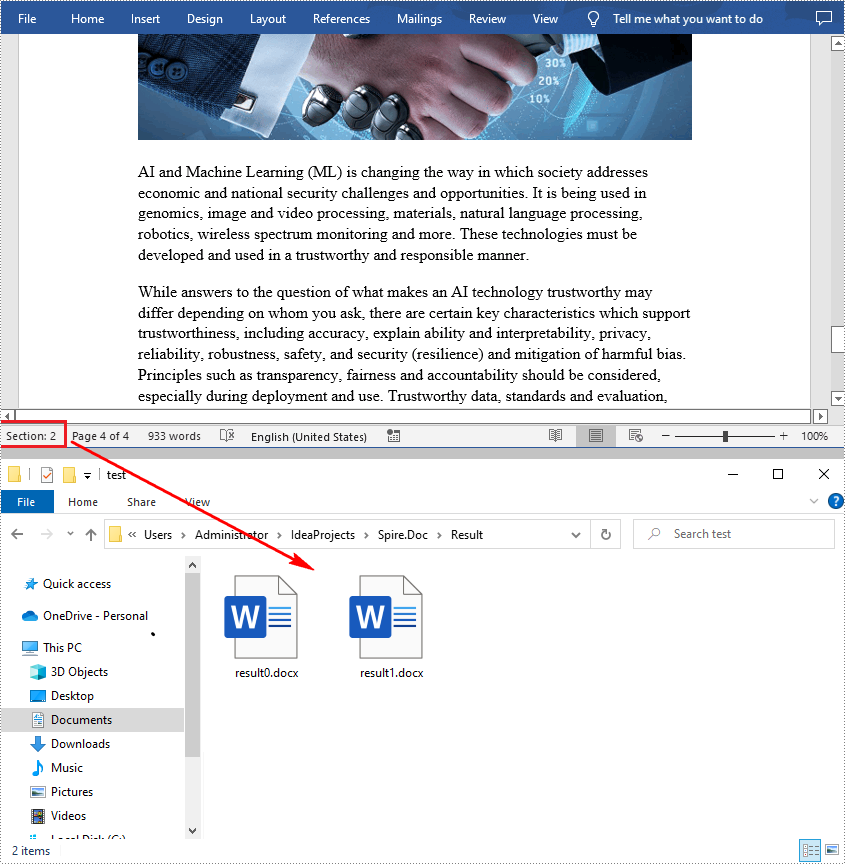
Apply for a Temporary License
If you'd like to remove the evaluation message from the generated documents, or to get rid of the function limitations, please request a 30-day trial license for yourself.
Java: Get All Revisions from Word
After you enable the Track Changes feature in a Word document, it records all the edits in the document, such as insertions, deletions, replacements, and format changes. Track Changes is a great feature allowing you to see what changes have been made to a document. This tutorial shows how to get all revisions from a Word document by using Spire.Doc for Java.
Install Spire.Doc for Java
First of all, you're required to add the Spire.Doc.jar file as a dependency in your Java program. The JAR file can be downloaded from this link. If you use Maven, you can easily import the JAR file in your application by adding the following code to your project's pom.xml file.
<repositories>
<repository>
<id>com.e-iceblue</id>
<name>e-iceblue</name>
<url>https://repo.e-iceblue.com/nexus/content/groups/public/</url>
</repository>
</repositories>
<dependencies>
<dependency>
<groupId>e-iceblue</groupId>
<artifactId>spire.doc</artifactId>
<version>13.11.2</version>
</dependency>
</dependencies>
Get All Revisions from Word
The detailed steps are as follows.
- Create a Document instance and load a sample Word document using Document.loadFromFile() method.
- Create a StringBuilder object and then using StringBuilder.append() method to log data.
- Traverse all the sections and every element under body in the section.
- Determine if the paragraph is an insertion revision or not using Paragraph.isInsertRevision() method. If yes, use Paragraph.getInsertRevision() method to get the insertion revision. Then get the revision type and author using EditRevision.getType() method and EditRevision.getAuthor() method.
- Determine if the paragraph is a delete revision or not using Paragraph.inDeleteRevision() method. If yes, use Paragraph.getDeleteRevision() method to get the delete revision. Then get the revision type and author using EditRevision.getType() method and EditRevision.getAuthor() method.
- Traverse all the elements in the paragraphs to get the text ranges' revisions.
- Write the content of StringBuilder to a txt document using FileWriter.write() method.
- Java
import com.spire.doc.*;
import com.spire.doc.documents.*;
import com.spire.doc.fields.*;
import com.spire.doc.formatting.revisions.*;
import java.io.FileWriter;
public class getRevisions {
public static void main(String[] args) throws Exception {
//Load the sample Word document
Document document = new Document();
document.loadFromFile("test file.docx");
//Create a StringBuilder object to get the insertions
StringBuilder insertRevision = new StringBuilder();
insertRevision.append("Insert revisions:"+"\n");
int index_insertRevision = 0;
//Create a StringBuilder object to get the deletions
StringBuilder deleteRevision = new StringBuilder();
deleteRevision.append("Delete revisions:"+"\n");
int index_deleteRevision = 0;
//Traverse all the sections
for (Section sec : (Iterable<Section>) document.getSections())
{
//Iterate through the element under body in the section
for(DocumentObject docItem : (Iterable<DocumentObject>)sec.getBody().getChildObjects())
{
if (docItem instanceof Paragraph)
{
Paragraph para = (Paragraph)docItem;
//Determine if the paragraph is an insertion revision
if (para.isInsertRevision())
{
index_insertRevision++;
insertRevision.append("Index: " + index_insertRevision+"\n");
//Get insertion revision
EditRevision insRevison = para.getInsertRevision();
//Get insertion revision type
EditRevisionType insType = insRevison.getType();
insertRevision.append("Type: " + insType+"\n");
//Get insertion revision author
String insAuthor = insRevison.getAuthor();
insertRevision.append("Author: " + insAuthor + "\n");
}
//Determine if the paragraph is a delete revision
else if (para.isDeleteRevision())
{
index_deleteRevision++;
deleteRevision.append("Index: " + index_deleteRevision +"\n");
EditRevision delRevison = para.getDeleteRevision();
EditRevisionType delType = delRevison.getType();
deleteRevision.append("Type: " + delType+ "\n");
String delAuthor = delRevison.getAuthor();
deleteRevision.append("Author: " + delAuthor + "\n");
}
//Iterate through the element in the paragraph
for(DocumentObject obj : (Iterable<DocumentObject>)para.getChildObjects())
{
if (obj instanceof TextRange)
{
TextRange textRange = (TextRange)obj;
//Determine if the textrange is an insertion revision
if (textRange.isInsertRevision())
{
index_insertRevision++;
insertRevision.append("Index: " + index_insertRevision +"\n");
EditRevision insRevison = textRange.getInsertRevision();
EditRevisionType insType = insRevison.getType();
insertRevision.append("Type: " + insType + "\n");
String insAuthor = insRevison.getAuthor();
insertRevision.append("Author: " + insAuthor + "\n");
}
else if (textRange.isDeleteRevision())
{
index_deleteRevision++;
deleteRevision.append("Index: " + index_deleteRevision +"\n");
//Determine if the textrange is a delete revision
EditRevision delRevison = textRange.getDeleteRevision();
EditRevisionType delType = delRevison.getType();
deleteRevision.append("Type: " + delType+"\n");
String delAuthor = delRevison.getAuthor();
deleteRevision.append("Author: " + delAuthor+"\n");
}
}
}
}
}
}
//Save to a .txt file
FileWriter writer1 = new FileWriter("insertRevisions.txt");
writer1.write(insertRevision.toString());
writer1.flush();
writer1.close();
//Save to a .txt file
FileWriter writer2 = new FileWriter("deleteRevisions.txt");
writer2.write(deleteRevision.toString());
writer2.flush();
writer2.close();
}
}

Apply for a Temporary License
If you'd like to remove the evaluation message from the generated documents, or to get rid of the function limitations, please request a 30-day trial license for yourself.
Java: Count the Number of Words in a Word Document
Microsoft Word provides a real-time word counter that counts the number of words in a document when you type. Beyond that, Microsoft Word also counts the number of pages, paragraphs and characters with or without spaces. In this article, you will learn how to programmatically count the number of words or characters in an existing Word document using Spire.Doc for Java.
Install Spire.Doc for Java
First of all, you're required to add the Spire.Doc.jar file as a dependency in your Java program. The JAR file can be downloaded from this link. If you use Maven, you can easily import the JAR file in your application by adding the following code to your project's pom.xml file.
<repositories>
<repository>
<id>com.e-iceblue</id>
<name>e-iceblue</name>
<url>https://repo.e-iceblue.com/nexus/content/groups/public/</url>
</repository>
</repositories>
<dependencies>
<dependency>
<groupId>e-iceblue</groupId>
<artifactId>spire.doc</artifactId>
<version>13.11.2</version>
</dependency>
</dependencies>
Count the Number of Words in a Word Document
The detailed steps are as follows:
- Create a Document instance.
- Load a sample Word document using Document.loadFromFile() method.
- Count the number of words using Document.getBuiltinDocumentProperties().getWordCount() method.
- Count the number of characters without spaces using Document.getBuiltinDocumentProperties().getCharCount() method.
- Count the number of characters with spaces using Document.getBuiltinDocumentProperties().getCharCountWithSpace() method.
- Java
import com.spire.doc.*;
public class countWordsNumber {
public static void main(String[] args) {
//Create a Document instance
Document document = new Document();
//Load a sample Word document
document.loadFromFile("Demo.docx");
//Count the number of words
System.out.println("WordCount: " + document.getBuiltinDocumentProperties().getWordCount());
//Count the number of characters without spaces
System.out.println("CharCount: " + document.getBuiltinDocumentProperties().getCharCount());
//Count the number of characters with spaces
System.out.println("CharCountWithSpace: " + document.getBuiltinDocumentProperties().getCharCountWithSpace());
}
}
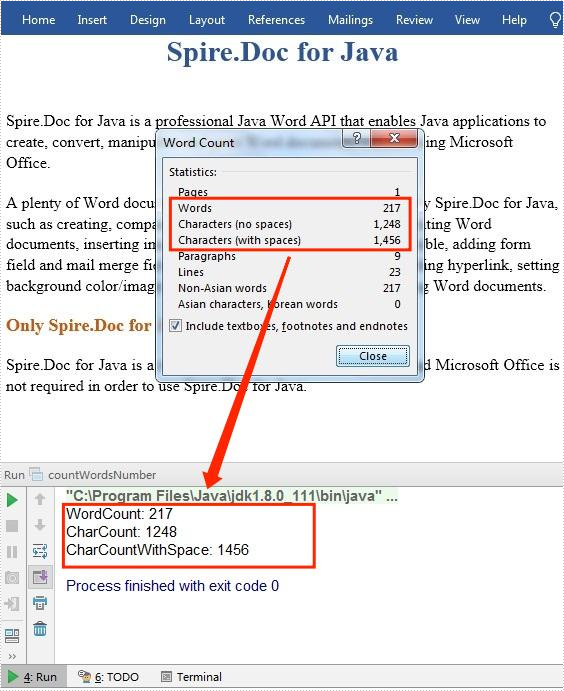
Apply for a Temporary License
If you'd like to remove the evaluation message from the generated documents, or to get rid of the function limitations, please request a 30-day trial license for yourself.
Java: Insert Math Equations in Word
Math equations are mathematical expressions commonly used in physics, engineering, computer science, and economics fields. When creating a professional Word document, you may sometimes need to include math equations to explain complex concepts, solve problems, or support specific arguments. In this article, you will learn how to insert math equations into Word documents in Java using Spire.Doc for Java.
Install Spire.Doc for Java
First of all, you're required to add the Spire.Doc.jar file as a dependency in your Java program. The JAR file can be downloaded from this link. If you use Maven, you can easily import the JAR file in your application by adding the following code to your project's pom.xml file.
<repositories>
<repository>
<id>com.e-iceblue</id>
<name>e-iceblue</name>
<url>https://repo.e-iceblue.com/nexus/content/groups/public/</url>
</repository>
</repositories>
<dependencies>
<dependency>
<groupId>e-iceblue</groupId>
<artifactId>spire.doc</artifactId>
<version>13.11.2</version>
</dependency>
</dependencies>
Insert Math Equations into a Word Document in Java
Spire.Doc for Java allows generating math equations from LaTeX code and MathML code using OfficeMath.fromLatexMathCode(String latexMathCode) and OfficeMath.fromMathMLCode(String mathMLCode) methods. The following are the detailed steps.
- Create two string arrays from LaTeX code and MathML code.
- Create a Document instance and add a section to it using Document.addSection() method.
- Iterate through each LaTeX code in the string array.
- Create a math equation from the LaTeX code using OfficeMath.fromLatexMathCode() method.
- Add a paragraph to the section, then add the math equation to the paragraph using Paragraph.getItems().add() method.
- Iterate through each MathML code in the string array.
- Create a math equation from the MathML code using OfficeMath.fromMathMLCode() method.
- Add a paragraph to the section, then add the math equation to the paragraph using Paragraph.getItems().add() method.
- Save the result document using Document.saveToFile() method.
- Java
import com.spire.doc.*;
import com.spire.doc.documents.*;
import com.spire.doc.fields.omath.*;
public class AddMathEquations {
public static void main(String[] args){
//Create a string array from LaTeX code
String[] latexMathCode = {
"x^{2}+\\sqrt{x^{2}+1}=2",
"\\cos (2\\theta) = \\cos^2 \\theta - \\sin^2 \\theta",
"k_{n+1} = n^2 + k_n^2 - k_{n-1}",
"\\frac {\\frac {1}{x}+ \\frac {1}{y}}{y-z}",
"\\int_0^ \\infty \\mathrm {e}^{-x} \\, \\mathrm {d}x",
"\\forall x \\in X, \\quad \\exists y \\leq \\epsilon",
"\\alpha, \\beta, \\gamma, \\Gamma, \\pi, \\Pi, \\phi, \\varphi, \\mu, \\Phi",
"A_{m,n} = \\begin{pmatrix} a_{1,1} & a_{1,2} & \\cdots & a_{1,n} \\\\ a_{2,1} & a_{2,2} & \\cdots & a_{2,n} \\\\ \\vdots & \\vdots & \\ddots & \\vdots \\\\ a_{m,1} & a_{m,2} & \\cdots & a_{m,n} \\end{pmatrix}",
};
//Create a string array from MathML code
String[] mathMLCode = {
"<math xmlns=\"http://www.w3.org/1998/Math/MathML\"><mi>a</mi><mo>≠</mo><mn>0</mn></math>",
"<math xmlns=\"http://www.w3.org/1998/Math/MathML\"><mi>a</mi><msup><mi>x</mi><mn>2</mn></msup><mo>+</mo><mi>b</mi><mi>x</mi><mo>+</mo><mi>c</mi><mo>=</mo><mn>0</mn></math>",
"<math xmlns=\"http://www.w3.org/1998/Math/MathML\"><mi>x</mi><mo>=</mo><mrow><mfrac><mrow><mo>−</mo><mi>b</mi><mo>±</mo><msqrt><msup><mi>b</mi><mn>2</mn></msup><mo>−</mo><mn>4</mn><mi>a</mi><mi>c</mi></msqrt></mrow><mrow><mn>2</mn><mi>a</mi></mrow></mfrac></mrow></math>",
};
//Create a Document instance
Document doc = new Document();
//Add a section
Section section = doc.addSection();
//Add a paragraph to the section
Paragraph textPara = section.addParagraph();
textPara.appendText("Creating Equations from LaTeX Code");
textPara.applyStyle(BuiltinStyle.Heading_1);
textPara.getFormat().setHorizontalAlignment(HorizontalAlignment.Center);
//Iterate through each LaTeX code in the string array
for (int i = 0; i < latexMathCode.length; i++)
{
//Create a math equation from the LaTeX code
OfficeMath officeMath = new OfficeMath(doc);
officeMath.fromLatexMathCode(latexMathCode[i]);
//Add the math equation to the section
Paragraph paragraph = section.addParagraph();
paragraph.getItems().add(officeMath);
section.addParagraph();
}
//Add a paragraph to the section
textPara = section.addParagraph();
textPara.appendText("Creating Equations from MathML Code");
textPara.applyStyle(BuiltinStyle.Heading_1);
textPara.getFormat().setHorizontalAlignment(HorizontalAlignment.Center);
//Iterate through each MathML code in the string array
for (int j = 0; j < mathMLCode.length; j++)
{
//Create a math equation from the MathML code
OfficeMath officeMath = new OfficeMath(doc);
officeMath.fromMathMLCode(mathMLCode[j]);
//Add the math equation to the section
Paragraph paragraph = section.addParagraph();
paragraph.getItems().add(officeMath);
section.addParagraph();
}
//Save the result document
doc.saveToFile("AddMathEquations.docx", FileFormat.Docx_2016);
doc.dispose();
}
}
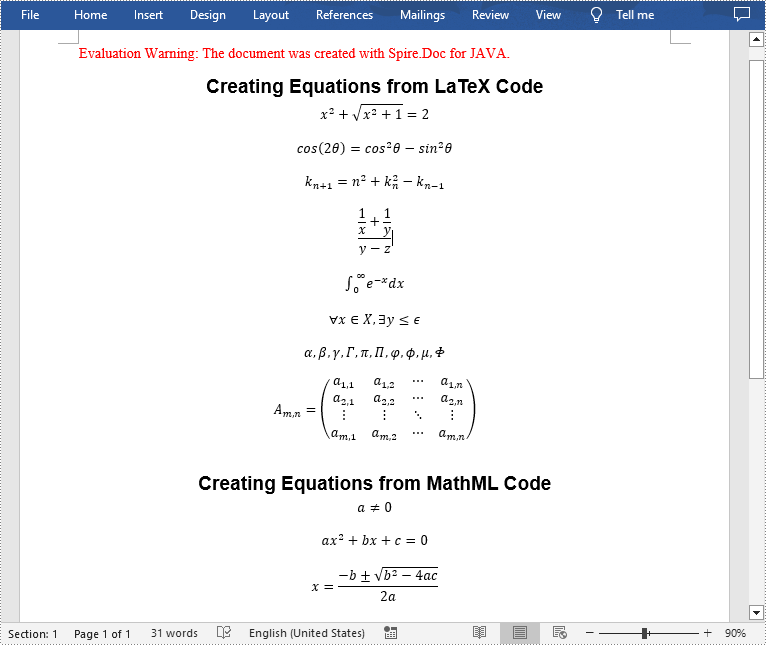
Apply for a Temporary License
If you'd like to remove the evaluation message from the generated documents, or to get rid of the function limitations, please request a 30-day trial license for yourself.
Java: Compare Two Word Documents
Document comparison is the process of checking new versions of a document against previous copies in order to identify changes made by different contributors. These differences may include additions or omissions of words, sentences or paragraphs, and formatting adjustments. This article demonstrates how to compare two Word documents in Java using Spire.Doc for Java.
- Compare Two Documents and Save Result in a Third Word Document
- Compare Two Documents and Return Insertions and Deletions in Lists
Below is a screenshot of the two Word documents that’ll be compared.

Install Spire.Doc for Java
First, you're required to add the Spire.Doc.jar file as a dependency in your Java program. The JAR file can be downloaded from this link. If you use Maven, you can easily import the JAR file in your application by adding the following code to your project's pom.xml file.
<repositories>
<repository>
<id>com.e-iceblue</id>
<name>e-iceblue</name>
<url>https://repo.e-iceblue.com/nexus/content/groups/public/</url>
</repository>
</repositories>
<dependencies>
<dependency>
<groupId>e-iceblue</groupId>
<artifactId>spire.doc</artifactId>
<version>13.11.2</version>
</dependency>
</dependencies>
Compare Two Documents and Save Result in a Third Word Document
Saving the comparison result in a separate Word document allows users to see all the changes made to the original document, including insertions, deletions as well as modifications on formatting. The following are the steps to compare two documents and save the result in a third Word document using Spire.Doc for Java.
- Load two Word documents separately while initialing the Document objects.
- Compare these two documents using Document.compare() method.
- Save the result in a third Word document using Document.saveToFile() method.
- Java
import com.spire.doc.Document;
import com.spire.doc.FileFormat;
public class CompareDocuments {
public static void main(String[] args) {
//Load one Word document
Document doc1 = new Document("C:\\Users\\Administrator\\Desktop\\original.docx");
//Load the other Word document
Document doc2 = new Document("C:\\Users\\Administrator\\Desktop\\revised.docx");
//Compare two documents
doc1.compare(doc2, "John");
//Save the differences in a third document
doc1.saveToFile("Differences.docx", FileFormat.Docx_2013);
doc1.dispose();
}
}
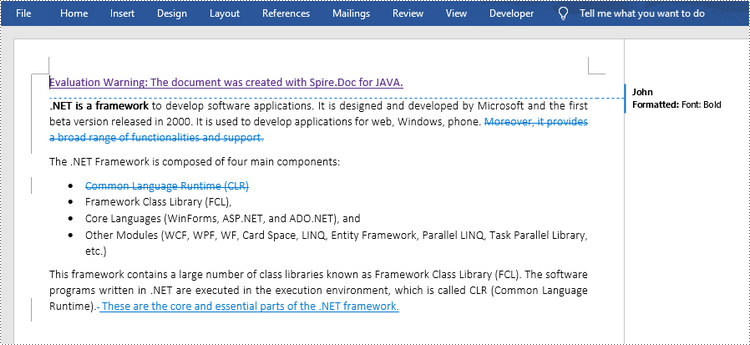
Compare Two Documents and Return Insertions and Deletions in Lists
Sometimes, we may only care about the insertions and deletions instead of the whole differences. The following are the steps to get insertions and deletions in two separate lists.
- Load two Word documents separately while initialing the Document objects.
- Compare two documents using Document.compare() method.
- Get the revisions using the constructor function of the DifferRevisions class.
- Get a list of insertions using DifferRevisions.getInsertRevisions() method.
- Get a list of deletions using DifferRevisions.getDeleteRevisions() method.
- Loop through the elements in the two lists to get the specific insertion and deletion.
- Java
import com.spire.doc.DifferRevisions;
import com.spire.doc.Document;
import com.spire.doc.DocumentObject;
import com.spire.doc.fields.TextRange;
import com.spire.ms.System.Collections.Generic.List;
public class CompareReturnResultsInLists {
public static void main(String[] args) {
//Load one Word document
Document doc1 = new Document("C:\\Users\\Administrator\\Desktop\\original.docx");
//Load the other Word document
Document doc2 = new Document("C:\\Users\\Administrator\\Desktop\\revised.docx");
//Compare the two Word documents
doc1.compare(doc2, "Author");
//Get the revisions
DifferRevisions differRevisions = new DifferRevisions(doc1);
//Return the insertion revisions in a list
List insertRevisionsList = differRevisions.getInsertRevisions();
//Return the deletion revisions in a list
List deleteRevisionsList = differRevisions.getDeleteRevisions();
//Create two int variables
int m = 0;
int n = 0;
//Loop through the insertion revision list
for (int i = 0; i < insertRevisionsList.size(); i++)
{
if (insertRevisionsList.get(i) instanceof TextRange)
{
m += 1;
//Get the specific revision and get its content
TextRange textRange = (TextRange)insertRevisionsList.get(i) ;
System.out.println("Insertion #" + m + ":" + textRange.getText());
}
}
System.out.println("============================================");
//Loop through the deletion revision list
for (int i = 0; i < deleteRevisionsList.size() ; i++)
{
if (deleteRevisionsList.get(i) instanceof TextRange)
{
n += 1;
//Get the specific revision and get its content
TextRange textRange = (TextRange) deleteRevisionsList.get(i) ;
System.out.println("Deletion #" + n + ":" + textRange.getText());
}
}
}
}

Apply for a Temporary License
If you'd like to remove the evaluation message from the generated documents, or to get rid of the function limitations, please request a 30-day trial license for yourself.
Add, Count, Retrieve and Remove Variables in Word in Java
This article demonstrates how to add, count, retrieve and remove variables in a Word document in Java using Spire.Doc for Java library.
Add a Variable
The following example adds a document variable named "A1" with a value of 12 to a Word document.
import com.spire.doc.Document;
import com.spire.doc.FieldType;
import com.spire.doc.FileFormat;
import com.spire.doc.Section;
import com.spire.doc.documents.Paragraph;
public class AddVariables {
public static void main(String[] args){
//Create a Document instance
Document document = new Document();
//Add a section
Section section = document.addSection();
//Add a paragraph to the section
Paragraph paragraph = section.addParagraph();
//Add a DocVariable field to the paragraph
paragraph.appendField("A1", FieldType.Field_Doc_Variable);
//Add a document variable to the DocVariable field
document.getVariables().add("A1", "12");
//Update fields in the document
document.isUpdateFields(true);
//Save the result document
document.saveToFile("AddVariables.docx", FileFormat.Docx_2013);
}
}

Count the number of Variables
import com.spire.doc.Document;
public class CountVariables {
public static void main(String[] args){
//Load the Word document
Document document = new Document();
document.loadFromFile("AddVariables.docx");
//Get the number of variables in the document
int number = document.getVariables().getCount();
StringBuilder content = new StringBuilder();
content.append("The number of variables is: " + number);
System.out.println(content.toString());
}
}

Retrieve Name and Value of a Variable
import com.spire.doc.Document;
public class RetrieveVariables {
public static void main(String[] args){
//Load the Word document
Document document = new Document();
document.loadFromFile("AddVariables.docx");
//Retrieve the name of a variable by index
String s1 = document.getVariables().getNameByIndex(0);
//Retrieve the value of a variable by index
String s2 = document.getVariables().getValueByIndex(0);
//Retrieve the value of a variable by name
String s3 = document.getVariables().get("A1");
System.out.println("The name of the variable retrieved by index 0 is: " + s1);
System.out.println("The value of the variable retrieved by index 0 is: " + s2);
System.out.println("The value of the variable retrieved by name \"A1\" is: " + s3);
}
}
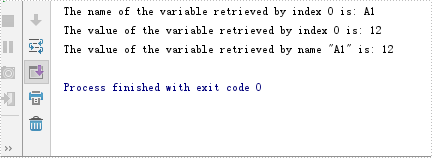
Remove a specific Variable
import com.spire.doc.Document;
import com.spire.doc.FileFormat;
public class RemoveVariables {
public static void main(String[] args){
//Load the Word document
Document document = new Document();
document.loadFromFile("AddVariables.docx");
//Remove a variable by name
document.getVariables().remove("A1");
//Update fields in the document
document.isUpdateFields (true);
//Save the result document
document.saveToFile("RemoveVariables.docx", FileFormat.Docx_2013);
}
}
Insert Math Equations and Symbols in Word Document in Java
This article demonstrates how to insert math equations i.e. Latex and MathML equations and Symbols in a Word document in Java using Spire.Doc for Java.
import com.spire.doc.Document;
import com.spire.doc.FileFormat;
import com.spire.doc.Section;
import com.spire.doc.Table;
import com.spire.doc.documents.Paragraph;
import com.spire.doc.fields.omath.OfficeMath;
public class AddMathEquationsAndSymbols {
public static void main(String[] args){
//Latex code
String[] latexMathCode1 = {
"x^{2}+\\sqrt{{x^{2}+1}}+1",
"2\\alpha - \\sin y + x",
};
//MathML code
String[] mathMLCode = {
"<mml:math xmlns:mml=\"http://www.w3.org/1998/Math/MathML\" xmlns:m=\"http://schemas.openxmlformats.org/officeDocument/2006/math\"><mml:msup><mml:mrow><mml:mi>x</mml:mi></mml:mrow><mml:mrow><mml:mn>2</mml:mn></mml:mrow></mml:msup><mml:mo>+</mml:mo><mml:msqrt><mml:msup><mml:mrow><mml:mi>x</mml:mi></mml:mrow><mml:mrow><mml:mn>2</mml:mn></mml:mrow></mml:msup><mml:mo>+</mml:mo><mml:mn>1</mml:mn></mml:msqrt><mml:mo>+</mml:mo><mml:mn>1</mml:mn></mml:math>",
"<mml:math xmlns:mml=\"http://www.w3.org/1998/Math/MathML\" xmlns:m=\"http://schemas.openxmlformats.org/officeDocument/2006/math\"><mml:mn>2</mml:mn><mml:mi>α</mml:mi><mml:mo>-</mml:mo><mml:mi>s</mml:mi><mml:mi>i</mml:mi><mml:mi>n</mml:mi><mml:mi>y</mml:mi><mml:mo>+</mml:mo><mml:mi>x</mml:mi></mml:math>",
};
//Latex code
String[] latexMathCode2 = {
"\\alpha",
"\\beta",
};
//Create a Document instance
Document doc = new Document();
//Load the Word document
doc.loadFromFile("MathEquationTemplate.docx");
//Get the first section
Section section = doc.getSections().get(0);
Paragraph paragraph = null;
OfficeMath officeMath;
//Insert Latex equations
Table table1 = section.getTables().get(0);
for (int i = 0; i < latexMathCode1.length; i++) {
paragraph = table1.getRows().get(i + 1).getCells().get(0).addParagraph();
paragraph.setText(latexMathCode1[i]);
paragraph = table1.getRows().get(i + 1).getCells().get(1).addParagraph();
officeMath = new OfficeMath(doc);
officeMath.fromLatexMathCode(latexMathCode1[i]);
paragraph.getItems().add(officeMath);
}
//Insert MathML equations
Table table2 = section.getTables().get(1);
for (int i = 0; i < mathMLCode.length; i++) {
paragraph = table2.getRows().get(i + 1).getCells().get(0).addParagraph();
paragraph.setText(mathMLCode[i]);
paragraph = table2.getRows().get(i + 1).getCells().get(1).addParagraph();
officeMath = new OfficeMath(doc);
officeMath.fromMathMLCode(mathMLCode[i]);
paragraph.getItems().add(officeMath);
}
//Insert Symbols
Table table3 = section.getTables().get(2);
for (int i = 0; i < latexMathCode2.length; i++) {
//Insert Latex code to the first column of the table
paragraph = table3.getRows().get(i + 1).getCells().get(0).addParagraph();
paragraph.setText(latexMathCode2[i]);
//Insert symbols to the second column of the table
paragraph = table3.getRows().get(i + 1).getCells().get(1).addParagraph();
officeMath = new OfficeMath(doc);
officeMath.fromLatexMathCode(latexMathCode2[i]);
paragraph.getItems().add(officeMath);
}
//Save the document
String result = "addMathEquationAndSymbols.docx";
doc.saveToFile(result, FileFormat.Docx_2013);
}
}
Output:

Java: Accept or Reject Tracked Changes in Word
Track Changes is a built-in feature in Microsoft Word which allows you to see all changes that were made to the document, and you can decide whether to accept or reject those changes. It is very useful especially when you are collaborating with multiple people on the same contracts or school assignments. In this article, you will learn how to programmatically accept or reject all tracked changes in a Word document using Spire.Doc for Java.
Install Spire.Doc for Java
First of all, you're required to add the Spire.Doc.jar file as a dependency in your Java program. The JAR file can be downloaded from this link. If you use Maven, you can easily import the JAR file in your application by adding the following code to your project's pom.xml file.
<repositories>
<repository>
<id>com.e-iceblue</id>
<name>e-iceblue</name>
<url>https://repo.e-iceblue.com/nexus/content/groups/public/</url>
</repository>
</repositories>
<dependencies>
<dependency>
<groupId>e-iceblue</groupId>
<artifactId>spire.doc</artifactId>
<version>13.11.2</version>
</dependency>
</dependencies>
Accept All Tracked Changes in a Word document
The detailed steps are as follows.
- Create a Document instance.
- Load a sample Word document using Document.loadFromFile() method.
- Accept all changes in the document using Document.acceptChanges() method.
- Save the document to another file using Document.saveToFile() method.
- Java
import com.spire.doc.Document;
import com.spire.doc.FileFormat;
public class AcceptTrackedChanges {
public static void main(String[] args) {
//Create a Document instance
Document doc = new Document();
//Load the sample Word document
doc.loadFromFile("test file.docx");
//Accept all changes in the document
doc.acceptChanges();
//Save the document
doc.saveToFile("AcceptAllChanges.docx", FileFormat.Docx);
}
}

Reject All Tracked Changes in a Word document
The detailed steps are as follows.
- Create a Document instance.
- Load a sample Word document using Document.loadFromFile() method.
- Reject all changes in the document using Document.rejectChanges() method.
- Save the document to another file using Document.saveToFile() method.
- Java
import com.spire.doc.Document;
import com.spire.doc.FileFormat;
public class RejectTrackedChanges {
public static void main(String[] args) {
//Create a Document instance
Document doc = new Document();
//Load the sample Word document
doc.loadFromFile("test file.docx");
//Reject all changes in the document
doc.rejectChanges();
//Save the document
doc.saveToFile("RejectAllChanges.docx", FileFormat.Docx);
}
}
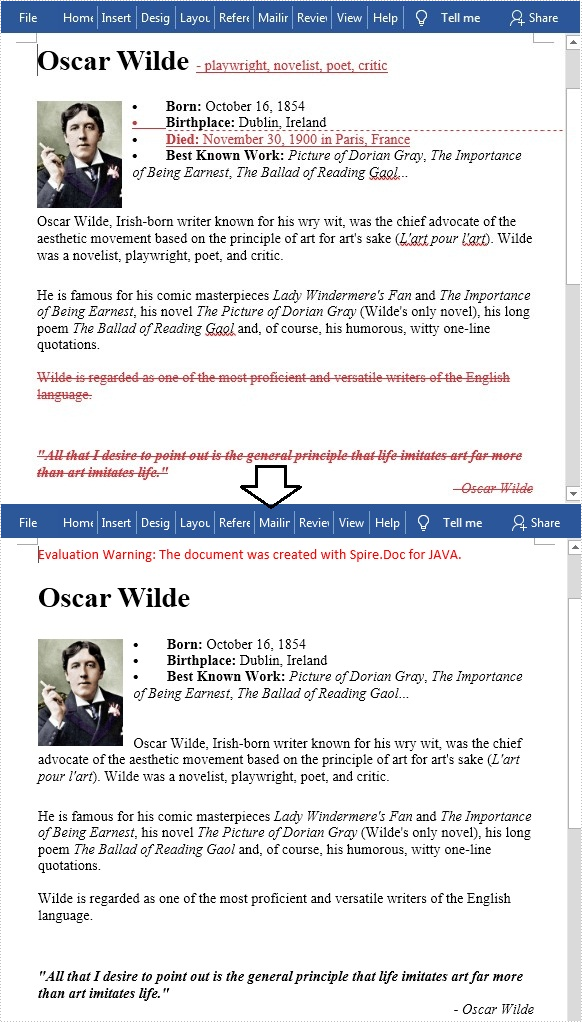
Apply for a Temporary License
If you'd like to remove the evaluation message from the generated documents, or to get rid of the function limitations, please request a 30-day trial license for yourself.
Java: Create a Table of Contents in Word
The table of contents is a field in a Word document that displays the headings of all levels and their corresponding page numbers in the document. Moreover, the table of contents can be updated after changes are made to the content of the document, and new headings and page numbers can be generated according to the new document content. Therefore, the table of contents can be a great convenience both when editing documents and reading them, while also making them more professional. This article is going to show how to insert the table of contents into Word documents through Java programs using Spire.Doc for Java.
- Create a Table of Contents with the Default Format
- Create a Table of Contents with Customized Format
Install Spire.Doc for Java
First, you're required to add the Spire.Doc.jar file as a dependency in your Java program. The JAR file can be downloaded from this link. If you use Maven, you can easily import the JAR file in your application by adding the following code to your project's pom.xml file.
<repositories>
<repository>
<id>com.e-iceblue</id>
<name>e-iceblue</name>
<url>https://repo.e-iceblue.com/nexus/content/groups/public/</url>
</repository>
</repositories>
<dependencies>
<dependency>
<groupId>e-iceblue</groupId>
<artifactId>spire.doc</artifactId>
<version>13.11.2</version>
</dependency>
</dependencies>
Create a Table of Contents with the Default Format
Before creating a table of contents, it is necessary to set the level for each heading, so that the table of contents can be generated according to each heading and its level. The level of a heading can be set by using the Paragraph.getListFormat().setListLevelNumber(int) method.
Spire.Doc for Java provides the Paragraph.appendTOC() method to insert a table of contents into a paragraph. The detailed steps for inserting a table of contents with the default style in a Word document are as follows:
- Create an object of Document class.
- Load a Word document using Document.loadFromFile() method.
- Add a section to the document using Document.addSection() method and insert it into the document after the cover section using Document.getSections().insert() method.
- Add a paragraph to the section using Section.addParagraph() method.
- Create a table of contents in the paragraph using Paragraph.appendTOC() method.
- Update the table of contents to display the headings in the document and their page numbers using Document.updateTableOfContents() method.
- Save the document using Document.saveToFile() method.
- Java
import com.spire.doc.Document;
import com.spire.doc.Section;
import com.spire.doc.documents.Paragraph;
import com.spire.doc.fields.TableOfContent;
public class insertTableOfContents {
public static void main(String[] args) {
//Create an object of Document class
Document doc = new Document();
//Load a Word document
doc.loadFromFile("Sample.docx");
//Add a section and insert it into the document after the cover section
Section section = doc.addSection();
doc.getSections().insert(1, section);
//Add a paragraph to the section
Paragraph paragraph = section.addParagraph();
paragraph.appendText("Table of Contents\r\n");
paragraph.getStyle().getCharacterFormat().setFontSize(14f);
//Create a table of contents in the paragraph
paragraph.appendTOC(2, 3);
//Update the table of contents
doc.updateTableOfContents();
//Save the document
doc.saveToFile("CreateTableOfContents.docx");
}
}
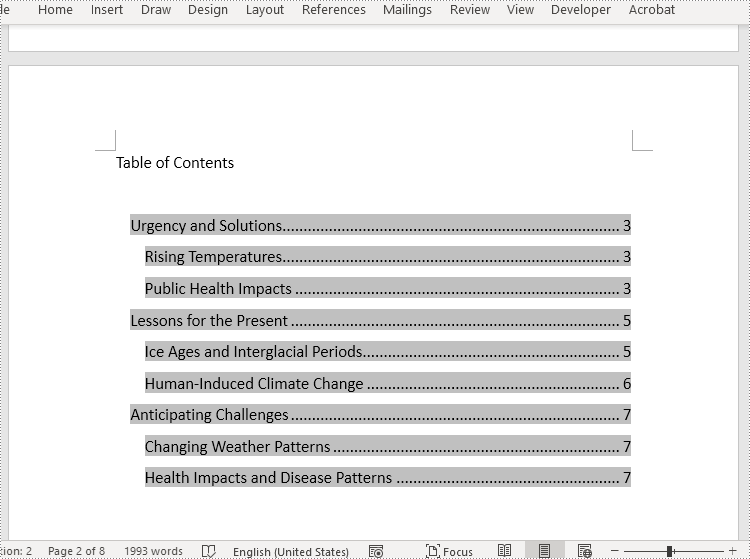
Create a Table of Contents with Customized Format
In Spire.Doc for Java, the TableOfContent class represents a table of contents of a Word document. The parts displayed in the table of contents can be customized by the switches while initializing an instance of the TableOfContent class. For example, the switches, "{\\o \"1-3\" \\n 1-2}", mean displaying the first to third level headings while omitting the page numbers of the first and second level headings.
The detailed steps for customizing a table of contents in a Word document are as follows:
- Create an object of Document class.
- Load a Word document using Document.loadFromFile() method.
- Insert a section after the cover section using Document.getSections().insert() method and add a paragraph to the section using Section.addParagraph() method.
- Create an instance of TableOfContent class to create a table of contents that displays the first to third level headings and omits page numbers of the first and second level headings.
- Insert the table of contents to the paragraph using Paragraph.getItems().add() method.
- Insert a field separator mark and a field end mark to the paragraph using Paragraph.appendFieldMark() method to end the table of contents field.
- Set the instance as the table of contents of the document using Document.setTOC() method.
- Update the table of contents to display the current contents for the document using Document.updateTableOfContents() method.
- Save the document using Document.saveToFile() method.
- Java
import com.spire.doc.Document;
import com.spire.doc.Section;
import com.spire.doc.documents.FieldMarkType;
import com.spire.doc.documents.Paragraph;
import com.spire.doc.fields.TableOfContent;
public class insertTableOfContentsWithCustomizedStyle {
public static void main(String[] args) {
//Create an object of Document class
Document doc = new Document();
//Load a Word document
doc.loadFromFile("Sample.docx");
//Insert a section after the first section and add a paragraph in the section
Section section = doc.addSection();
doc.getSections().insert(1, section);
Paragraph paragraph = section.addParagraph();
paragraph.getStyle().getCharacterFormat().setFontSize(14f);
//Initialize an instance of TableOfContent class
TableOfContent toc = new TableOfContent(doc, "{\\o \"1-3\" \\n 1-2}");
//Insert the table of contents to the document
paragraph.getItems().add(toc);
//Insert field marks to end the field
paragraph.appendFieldMark(FieldMarkType.Field_Separator);
paragraph.appendFieldMark(FieldMarkType.Field_End);
//Set the created table of contents as the table of contents of the document
doc.setTOC(toc);
//Update the table of contents
doc.updateTableOfContents();
//Save the document
doc.saveToFile("TableOfContentsWithCustomizedStyle.docx");
doc.dispose();
}
}

Apply for a Temporary License
If you'd like to remove the evaluation message from the generated documents, or to get rid of the function limitations, please request a 30-day trial license for yourself.
Add Content Controls to Word Document in Java
This article demonstrates how to add combo box, check box, text, picture, date picker and drop-down list content controls to a Word document using Spire.Doc for Java.
import com.spire.doc.*;
import com.spire.doc.documents.*;
import com.spire.doc.fields.*;
import java.util.Date;
public class ContentControls {
public static void main(String[] args){
//create a new Word document
Document document = new Document();
Section section = document.addSection();
Paragraph paragraph = section.addParagraph();
TextRange txtRange = paragraph.appendText("The following example shows how to add content controls in a Word document.");
section.addParagraph();
//add combo box content control
paragraph = section.addParagraph();
txtRange = paragraph.appendText("Add Combo Box Content Control: ");
txtRange.getCharacterFormat().setItalic(true);
StructureDocumentTagInline sd = new StructureDocumentTagInline(document);
paragraph.getChildObjects().add(sd);
sd.getSDTProperties().setSDTType(SdtType.Combo_Box);
sd.getSDTProperties().setAlias("ComboBox");
sd.getSDTProperties().setTag("ComboBox");
SdtComboBox cb = new SdtComboBox();
cb.getListItems().add(new SdtListItem("Spire.Doc"));
cb.getListItems().add(new SdtListItem("Spire.XLS"));
cb.getListItems().add(new SdtListItem("Spire.PDF"));
sd.getSDTProperties().setControlProperties(cb);
TextRange rt = new TextRange(document);
rt.setText(cb.getListItems().get(0).getDisplayText());
sd.getSDTContent().getChildObjects().add(rt);
section.addParagraph();
//Add checkbox content control
paragraph = section.addParagraph();
txtRange = paragraph.appendText("Add Check Box Content Control: ");
txtRange.getCharacterFormat().setItalic(true);
sd = new StructureDocumentTagInline(document);
paragraph.getChildObjects().add(sd);
sd.getSDTProperties().setSDTType(SdtType.Check_Box);
sd.getSDTProperties().setAlias("CheckBox");
sd.getSDTProperties().setTag("CheckBox");
SdtCheckBox scb = new SdtCheckBox();
sd.getSDTProperties().setControlProperties(scb);
rt = new TextRange(document);
sd.getChildObjects().add(rt);
scb.setChecked(true);
section.addParagraph();
//add text content control
paragraph = section.addParagraph();
txtRange = paragraph.appendText("Add Text Content Control: ");
txtRange.getCharacterFormat().setItalic(true);
sd = new StructureDocumentTagInline(document);
paragraph.getChildObjects().add(sd);
sd.getSDTProperties().setSDTType(SdtType.Text);
sd.getSDTProperties().setAlias("Text");
sd.getSDTProperties().setTag("Text");
SdtText text = new SdtText(true);
text.isMultiline(true);
sd.getSDTProperties().setControlProperties(text);
rt = new TextRange(document);
rt.setText("Text");
sd.getSDTContent().getChildObjects().add(rt);
section.addParagraph();
//add picture content control
paragraph = section.addParagraph();
txtRange = paragraph.appendText("Add Picture Content Control: ");
txtRange.getCharacterFormat().setItalic(true);
sd = new StructureDocumentTagInline(document);
paragraph.getChildObjects().add(sd);
sd.getSDTProperties().setControlProperties(new SdtPicture());
sd.getSDTProperties().setAlias("Picture");
sd.getSDTProperties().setTag("Picture");
DocPicture pic = new DocPicture(document);
pic.setWidth(10f);
pic.setHeight(10f);
pic.loadImage("logo.png");
sd.getSDTContent().getChildObjects().add(pic);
section.addParagraph();
//add date picker content control
paragraph = section.addParagraph();
txtRange = paragraph.appendText("Add Date Picker Content Control: ");
txtRange.getCharacterFormat().setItalic(true);
sd = new StructureDocumentTagInline(document);
paragraph.getChildObjects().add(sd);
sd.getSDTProperties().setSDTType(SdtType.Date_Picker);
sd.getSDTProperties().setAlias("Date");
sd.getSDTProperties().setTag("Date");
SdtDate date = new SdtDate();
date.setCalendarType(CalendarType.Default);
date.setDateFormat("yyyy.MM.dd");
date.setFullDate(new Date());
sd.getSDTProperties().setControlProperties(date);
rt = new TextRange(document);
rt.setText("2018.12.25");
sd.getSDTContent().getChildObjects().add(rt);
section.addParagraph();
//add drop-down list content control
paragraph = section.addParagraph();
txtRange = paragraph.appendText("Add Drop-Down List Content Control: ");
txtRange.getCharacterFormat().setItalic(true);
sd = new StructureDocumentTagInline(document);
paragraph.getChildObjects().add(sd);
sd.getSDTProperties().setSDTType(SdtType.Drop_Down_List);
sd.getSDTProperties().setAlias("DropDownList");
sd.getSDTProperties().setTag("DropDownList");
SdtDropDownList sddl = new SdtDropDownList();
sddl.getListItems().add(new SdtListItem("Harry"));
sddl.getListItems().add(new SdtListItem("Jerry"));
sd.getSDTProperties().setControlProperties(sddl);
rt = new TextRange(document);
rt.setText(sddl.getListItems().get(0).getDisplayText());
sd.getSDTContent().getChildObjects().add(rt);
//save the resultant document
document.saveToFile("addContentControls.docx", FileFormat.Docx_2013);
}
}
Output:
